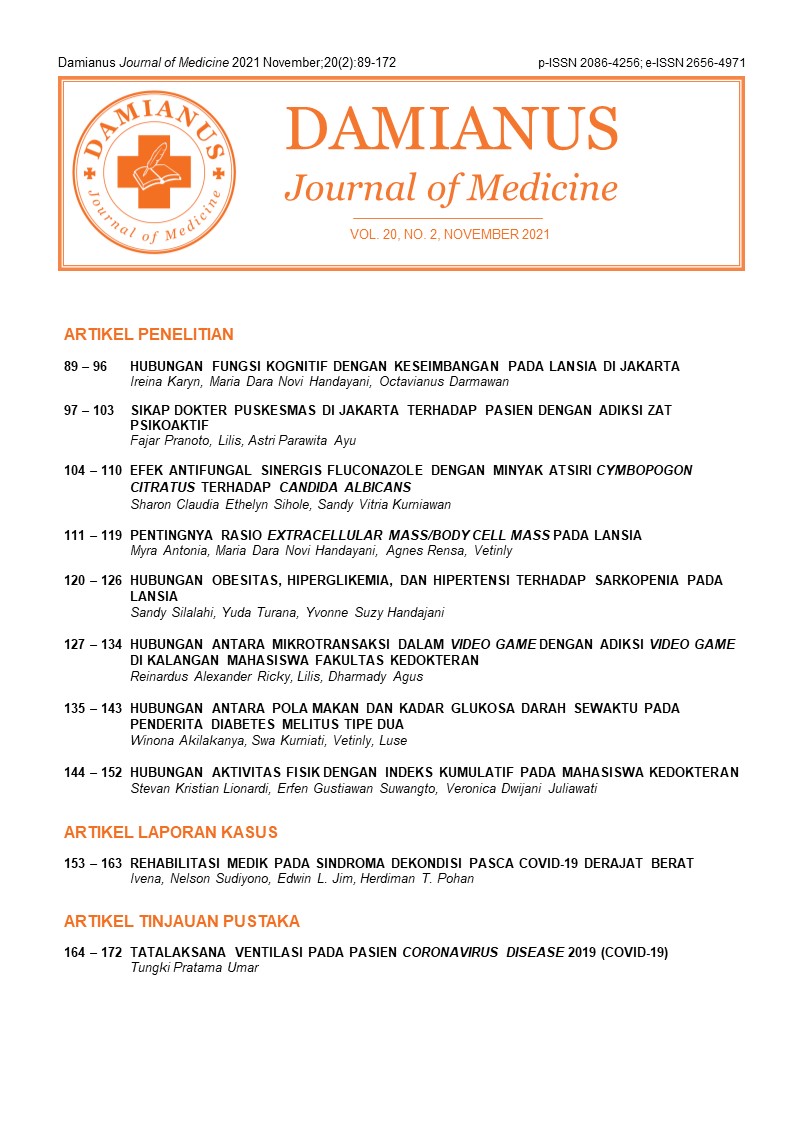Ventilation Management for the Coronavirus Disease 2019 (Covid-19) Patient
Ventilation in COVID-19 Patients
DOI:
https://doi.org/10.25170/djm.v20i2.2389Keywords:
Coronavirus Disease 2019, Intubation, Oxygen TherapyAbstract
Introduction: Coronavirus disease 2019 (COVID-19) is a respiratory infection that has become a global pandemic. Approximately 5% of all sufferers of this disease require an intensive care unit, with Acute Respiratory Distress Syndrome (ARDS) as one of the main complications with a mortality ratio reaching 94%. COVID-19 which disrupts the respiratory system requires adequate management, especially in ventilation or oxygenation to reduce the risk of multi-organ damage. The author discusses this topic in this literature review.
Results: Ventilation management in COVID-19 patients must adhere to the principles of Safe (for staff and patients), Accurate (preventing unusual techniques), and Swift (fast). Airway management in COVID-19 patients has a very high risk because of the large opportunity for aerosolization to occur. Providing ventilation (oxygenation) to patients with COVID-19 has many options, ranging from the nasal cannula, face mask, rebreathing masks, Venturi Mask, Non-rebreathing Mask (NRM), High Flow Nasal Cannula, Non-Invasive Ventilation (NIV), to intubation with mechanical ventilation. Regarding intubation, until now there is no specific protocol, especially regarding disagreements about early or late intubation.
Conclusion: The choice of oxygen administration technique, as well as the decision to intubate, largely depended on the discretion of the anesthetist who is present and assesses it according to the individual needs and clinical status of the patient.
Downloads
References
2. Yao W, Wang T, Jiang B, Gao F, Wang L, Zheng H, et al. Emergency tracheal intubation in 202 patients with COVID-19 in Wuhan, China: lessons learnt and international expert recommendations. Br J Anaesth. 2020;125(1):e28–37.
3. Widhani A, Rengganis I, Susanto AJ, et al. Factors Related to Knowledge, Perception, and Practices Towards COVID-19 Among Patients with Autoimmune Diseases: A Multicenter Online Survey. Acta Med Indones. 2020;52(3):214–26.
4. Huang C, Wang Y, Li X, et al. Clinical features of patients infected with 2019 novel coronavirus in Wuhan, China. Lancet. 2020;395(10223):497–506.
5. Guan W, Ni Z, Hu Y, et al. China Medical Treatment Expert Group for C: Clinical characteristics of coronavirus disease 2019 in China. N Engl J Med. 2020;382:1708-1720.
6. Fong MW, Gao H, Wong JY, et al. Nonpharmaceutical Measures for Pandemic Influenza in Nonhealthcare Settings-Social Distancing Measures. Emerg Infect Dis. 2020 May;26(5):976–84.
7. Clark A, Jit M, Warren-Gash C, et al. Global, regional, and national estimates of the population at increased risk of severe COVID-19 due to underlying health conditions in 2020: a modelling study. Lancet Glob Heal. 2020;8(8):e1003–17.
8. Setiati S, Azwar MK. COVID-19 and Indonesia. Acta Med Indones. 2020;52(1):84–9.
9. Yang X, Yu Y, Xu J, et al. Clinical course and outcomes of critically ill patients with SARS-CoV-2 pneumonia in Wuhan, China: a single-centered, retrospective, observational study. Lancet Respir Med. 2020;8(5):475–81.
10. Wang D, Hu B, Hu C, Zhu F, Liu X, Zhang J. Clinical Characteristics of 138 Hospitalized Patients With 2019 Novel Coronavirus–Infected Pneumonia in Wuhan, China. JAMA. 2020;323(11):1061–9.
11. Mao L, Jin H, Wang M, et al. Neurologic Manifestations of Hospitalized Patients With Coronavirus Disease 2019 in Wuhan, China. JAMA Neurol. 2020;77(6):683–90.
12. World Health Organization Indonesia. COVID-19 collaboration brings ventilators to Indonesia [Internet]. Geneva: World Health Organization [cited 2020 Dec 3]. Available from: https://www.who.int/indonesia/news/detail/05-06-2020-covid-19-collaboration-brings-ventilators-to-indonesia
13. Meng L, Qiu H, Wan L, et al. Intubation and Ventilation amid the COVID-19 Outbreak: Wuhan’s Experience. Anesthesiology. 2020;132(6):1317–32.
14. Wells CR, Fitzpatrick MC, Sah P, et al. Projecting the demand for ventilators at the peak of the COVID-19 outbreak in the USA. Lancet Infect Dis. 2020;20(10):1123–5.
15. Lidwina A. Berapa Jumlah Ketersediaan dan Kebutuhan Ventilator di Indonesia? [Internet]. Jakarta: Kata Data [cited 2020 Dec 3]. Available from: https://databoks.katadata.co.id/datapublish/2020/04/14/berapa-jumlah-ketersediaan-dan-kebutuhan-ventilator-di-indonesia
16. Buheji M, Cunha K da C, Rocha RSB. Ventilators in COVID-19, Between Scarcity and Abundance Mindset. Int J Adv Res Eng Technol. 2020;11(10):751–67.
17. Cook TM, El-Boghdadly K, McGuire B, McNarry AF, Patel A, Higgs A. Consensus guidelines for managing the airway in patients with COVID-19: Guidelines from the Difficult Airway Society, the Association of Anaesthetists the Intensive Care Society, the Faculty of Intensive Care Medicine and the Royal College of Anaesthetist. Anaesthesia. 2020;75:785–799.
18. Orser BA. Recommendations for Endotracheal Intubation of COVID-19 Patients. Anesth Analg. 2020;130(5):1109–10.
19. Caputo KM, Byrick R, Chapman MG, Orser BA, Orser BJ. Intubation of SARS patients: Infection and perspectives of healthcare workers. Can J Anesth. 2006;53(2):122-9.
20. Liu Y, Yan LM, Wan L, et al. Viral dynamics in mild and severe cases of COVID-19. Lancet Infect Dis. 2020;20(6):656–657.
21. Pasnick S, Carlos WG, Dela Cruz CS, Gross JE, Garrison G, Jamil S. SARS-CoV-2 Transmission and the Risk of Aerosol-Generating Procedures. Am J Respir Crit Care Med. 2020;202(4):P13–4.
22. Islam MM, Ullah SMA, Mahmud S, Raju SMTU. Breathing Aid Devices to Support Novel Coronavirus (COVID-19) Infected Patients. SN Comput Sci. 2020;1(5):274.
23. Whittle JS, Pavlov I, Sacchetti AD, Atwood C, Rosenberg MS. Respiratory support for adult patients with COVID-19. J Am Coll Emerg Physicians open. 2020;1(2):95–101.
24. Roy A, Singh A, Khanna P. Oxygen Delivery Devices in Covid 19 Patients: Review and Recommendation. Bali J Anesthesiol. 2020;4:S3-7.
25. Perhimpunan Dokter Spesialis Anestesi dan Terapi Intensif Indonesia. Buku Pedoman Penanganan Pasien Kritis Covid-19. 1st ed. Jakarta: Perhimpunan Dokter Spesialis Anestesi dan Terapi Intensif Indonesia; 2020.
26. Kangelaris KN, Ware LB, Wang CY, et al. Timing of Intubation and Clinical Outcomes in Adults With Acute Respiratory Distress Syndrome. Crit Care Med. 2016;44(1):120–9.
27. Brochard L, Slutsky A, Pesenti A. Mechanical Ventilation to Minimize Progression of Lung Injury in Acute Respiratory Failure. Am J Respir Crit Care Med. 201;195(4):438–42.
28. Spoletini G, Alotaibi M, Blasi F, Hill NS. Heated Humidified High-Flow Nasal Oxygen in Adults: Mechanisms of Action and Clinical Implications. Chest. 2015;148(1):253–61.
29. Ahmad I, Jeyarajah J, Nair G, et al. A prospective, observational, cohort study of airway management of patients with COVID-19 by specialist tracheal intubation teams. Can J Anesth Can d’anesthésie. 2021;68:196–203.
30. Intensive Care National Audit and Research Centre. ICNARC report on COVID-19 in critcal care: England, Wales and Northern Ireland. London: Intensive Care National Audit and Research Centre; 2020.
31. Rola P, Farkas J, Spiegel R, et al. Rethinking the early intubation paradigm of COVID-19: time to change gears? Clin Exp Emerg Med. 2020;7(2):78–80.
32. Lee YH, Choi K-J, Choi SH, et al. Clinical Significance of Timing of Intubation in Critically Ill Patients with COVID-19: A Multi-Center Retrospective Study. J Clin Med. 2020;9(9):2847.
33. Tran K, Cimon K, Severn M, Pessoa-Silva CL, Conly J. Aerosol generating procedures and risk of transmission of acute respiratory infections to healthcare workers: a systematic review. PLoS One. 2012;7(4):e35797.
34. Hernandez-Romieu AC, Adelman MW, Hockstein MA, Robichaux CJ, Edwards JA, Fazio JC, et al. Timing of Intubation and Mortality Among Critically Ill Coronavirus Disease 2019 Patients: A Single-Center Cohort Study. Crit Care Med. 2020;48(11):e1045–53.
35. Matta SK. Dilemmas in Covid-19 Respiratory Distress: Early vs Late Intubation; High Tidal Volume and Low PEEP vs Traditional Approach? J Intensive Crit Care. 2020;6(2):7.
36. Matta A, Chaudhary S, Bryan LK, et al. Timing of Intubation and Its Implications on Outcomes in Critically Ill Patients With Coronavirus Disease 2019 Infection. Crit Care Explor. 2020;2(10): e0262.
37. Khandelwal A, Singh GP, Rath GP, Chaturvedi A. The “COVID-19 Score” can predict the need for tracheal intubation in critically ill COVID-19 patients – A hypothesis. Med Hypotheses. 2020;144:110292.
38. Lopez RA, Anthony A, Zuo L, Enomoto TM, Aziz MF. Your COVID-19 Intubation Kit. Anesth Analg. 2020; 131(1): e28-e30.
39. Tsai PB. Barrier Shields: Not Just for Intubations in Today’s COVID-19 World? Anesth Analg. 2020; 131(1): e44-e45.
40. Sorbello M, Rosenblatt W, Hofmeyr R, Greif R, Urdaneta F. Aerosol boxes and barrier enclosures for airway management in COVID-19 patients: a scoping review and narrative synthesis. Br J Anaesth. 2020;125(6):880–894.














